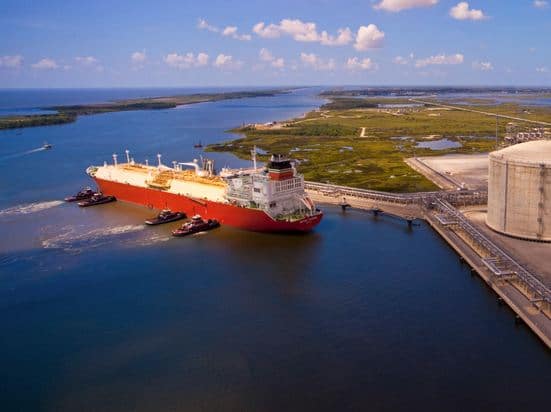Yesterday, LNG World News reported that ExxonMobil Vice President Andrew Swiger announced, at a conference hosted by Bank of America Merrill Lynch, that it was actively seeking LNG (liquefied natural gas) export terminals throughout North America, including, but not limited to, in British Columbia and on the Gulf Coast.
“In terms of exports from North America, whether it is the Gulf Coast or whether it is Western Canada, it’s something we’re actively looking at,” said Swiger.
So, where are these prospective export terminals located, what are the key pipelines carrying the unconventional gas produced from shale basins, and what are the key shale basins in the mix? Hold tight for an explanation.
Golden Pass LNG Terminal and Golden Pass Pipeline
The LNG World News article explains that ExxonMobil “has a stake in the Golden Pass LNG Terminal in Texas,” but does not explain exactly what the “stake” is.
A bit of research shows that ExxonMobil is a 17.6% stakeholder in the Golden Pass LNG Terminal, according to a March 2011 article publshed by Platts. It is co-owned by ConocoPhillips and Qatar Petroleum, who own a 12.4% and 70% stake in Golden Pass LNG, respectively.
Golden Pass LNG is stationed in Sabine Pass, TX, located on the Gulf Coast on the Texas-Louisiana border, which is in close proximity to Cheniere’s Sabine Pass LNG export terminal, a terminal which has been written about in-depth by DeSmogBlog.
As of now, Golden Pass is an import terminal, and “is among the largest LNG import facilities worldwide, with the capacity to import 15.6 million metric tons of LNG annually,” explains LNG World News. But many import facilities have turned into export facilities, including the Jordan Cove LNG terminal in Coos Bay, Oregon, the Dominion Cove LNG terminal in Lusby, Maryland, and Kitimat LNG terminal in Kitimat, British Columbia. Gas corporations often execute the bait-and-switch, transforming what were originally import terminals into export terminals.
If history repeats itself, which is highly likely based on this latest report from LNG World News, then the Golden Pass LNG Terminal could soon be transformed into an export terminal, making it export terminal number two in Sabine Pass.
It appears for now that the gas would come from the shale basins surrounding Sabine Pass, meaning the Barnett Shale, the Eagle Ford Shale, the Haynesville Shale, and the Fayetteville Shale, and flow out these respective shale basins via an extensive pipeline system, to the key Golden Pass and Sabine Pass hubs.
For example, Golden Pass also owns Golden Pass Pipeline, which runs from the Haynesville Shale down to the Golden Pass LNG terminal.
Horn River Basin Shale and Pacific Trail Pipelines
LNG World News’ article also mentions that ExxonMobil “has 340,000 shale gas acres in Western Canada’s Horn River Basin.” The Horn River Shale Basin is located in northeastern British Columbia and sits on 250 trillion cubic feet of unconventional gas, producred through the toxic hydraulic fracturing, or fracking process.
Assuming ExxonMobil holds true to the pronouncement made by Swiger, much of the gas produced in the Horn River Basin will flow westward to Kitimat LNG export terminal, which ships gas to the Asian market.
One of these facilities is co-owned by EOG Resources (EOG), EnCana Corporation (EnCana), and Apache Corporation (Apache). In October 2011, Canada’s National Energy Board, the Canadian equivalent to the U.S. Federal Energy Regulatory Commission, granted Kitimat LNG a 20-year Export Licence to serve international markets. The Pacific Trail Pipelines connect the Horn River Basin to the Kitimat LNG facility and are also co-owned by EOG, EnCana, and Apache.
Another key LNG export terminal in the works will be co-owned by Shell, Korea Gas Corporation, China National Petroleum Corporation, and Mitsubishi Corporation.
The Globe and Mail explained the looming deal, writing
Shell is examining plans for a 3.6 billion cubic feet a day project, which would be among the largest under consideration in the world…Kitimat LNG intends to build a 700-million cubic foot facility first, at a cost greater than $5-billion, but has received an export licence that allows it to double that. The partnership intends to make a final investment decision early next year, but is already spending several hundred million dollars to terrace the sloped site of the intended terminal, the first step in construction.
A pipeline arrangement paralleling the EOG, EnCana, Apache agreement will likely follow the Shell export deal announcement, carrying gas fracked from the Horn River Shale Basin to Kitimat, in order to be exported, in the form of LNG, to the profitable Asian market.
North American Export Market a Huge Racket
As is now perfectly clear and has been made clear by DeSmogBlog on multiple occasions, not only is the unconventional gas industry unconcerned with the “domestic consumption” of gas for “national security” purposes, but perhaps even more importantly, two of the largest fossil fuel corporations in the world, Shell and ExxonMobil, are now in the fray of the export game.
Deals of this nature will likely proliferate as time progresses, with what has been coined the “one-percent” by the Occupy Wall Street movement, standing with the most to gain from them.
Subscribe to our newsletter
Stay up to date with DeSmog news and alerts







